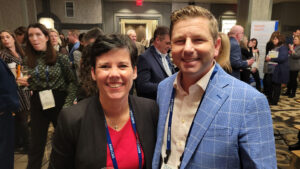As biosimilars make inroads across various disease states, oncology especially appears to have embraced the new breed of therapies. Biosimilar adoption, however, is not as simple as picking the lowest-cost option, according to one expert.
Deciding which biosimilars to use requires a complex set of considerations for oncology clinics, notes Andre Harvin, PharmD, Executive Director of Pharmacy and Oncology Services at Cone Health. He made his comments as keynote speaker at the Association of Community Cancer Centers (ACCC) 49th Annual Meeting & Cancer Center Business Summit in March 2023.
Oncology was a great target area for some of the first biologic manufacturers, says Harvin, pointing to skyrocketing costs of oncology. “There’s a need to reduce the cost of care, increase patient access, and really slow the curve of what it costs to be treated for cancer here in the United States.”
Harvin notes that 2019 and 2020 were big years for biosimilars in oncology when utilization appears to have increased dramatically. According to an April 2023 study published in JCO Oncology Practice, over the three-year period ending in the fourth quarter of 2021, biosimilar adoption reached between 51% and 80% of administered doses, depending on the biologic. The study examined the use of six biosimilars across 38 practices between 2019 and 2021. The trend resulted in average cost per dose decreases of between 24% and 41%, depending on the product.
The arrival of biosimilars has also complicated the picture for oncology practices. For instance, pegfilgrastim now has five or six different biosimilars in addition to the reference product.
“If you’re a physician wanting to put a patient on a drug, you have to say, ‘Well, hold on, this patient has insurance A. And for them, their formulary says they can use either the reference drug or the biosimilar,’” Harvin says of one such consideration. “And you’re doing that a dozen times a day.”
Adding to the complication are the sheer number of managed care plans—both commercial and government—that all operate their own formularies and change their formularies every few months based on deals they’re making with new manufacturers entering the market.
“Payer coverage is kind of wreaking its own havoc of, ‘Am I choosing the right biosimilar for this patient based on their payer?’” Harvin notes.
Tried and True Strategy?
Meanwhile, many oncology practices continue trying to follow the tired-and-true practice of choosing the least expensive biosimilar for the patient. “But that strategy can go awry pretty quickly,” he adds, noting the complexity of the biosimilar market.
First off, biosimilars can have vastly different prices, Harvin says, usually somewhere between 2% to 24% less than the reference medication. Secondly, biosimilars appear to generate a wide range of reimbursement arrangements. “One payer may reimburse you as a percent of charges,” Harvin explains. “The next payer may reimburse you based on the fee schedule, and then you may have another payer that reimburses based on value, looking at the outcomes of the therapy.”
Even getting to the true net acquisition costs on the pharmacy side is sometimes somewhat difficult.
Oncology clinics might assume the cost is simply what their wholesaler indicates. But it could easily include rebates that depend on using a certain percentage of this brand to get back additional dollars at the end of the quarter or the end of the year.
“Then you’ve got to find a way to bring that all together and answer the question of, financially, what is the best biosimilar for me and my organization based on the unique payer for this specific patient?” Harvin says.
Such considerations often come down to a question of money, especially given the fact biosimilars by definition contain no clinical differences. Biosimilar A might offer the practice $100. But biosimilar C might result in a net amount of $150.
“I think everybody would say, ‘Yes, let me go ahead and give Brand C,’ because we’re going to bring in more net money for that,” he says. But he adds that such a decision point is difficult to make on a day-to-day, patient-to-patient basis.
Level of Nuance Can Be “Nauseating”
“There are so many nuances that are involved with trying to make the very best financial decision around biosimilars that is sometimes nauseating,” Harvin says.
Currently, such considerations center on roughly six main cancer drugs that have biosimilars on the market: epoetin alfa, filgrastim, pegfilgrastim, bevacizumab, rituximab, and trastuzumab. “What about in five years from now where we’ve got a dozen agents with biosimilars?” Harvin says. “It’s going to be a really, really challenging approach to it if we don’t figure this out right now.”
He advises each oncology practice—including the pharmacy, managed care, billing, coding, and prior authorization teams—to come together to understand the challenges that biosimilars bring to the market.
He also points out that just because biosimilars are cheaper than the reference product, clinics will still have a lot of patients who can’t afford them. “And that’s because cancer care is expensive,” Harvin says. “It’s important to note that every single biosimilar manufacturer has their own patient assistance program. And it is critically important that as an institution, you connect your patients with those resources when necessary.”
While biosimilars have the potential to save billions of dollars, oncology clinics need to better optimize their use. “We’ve got so many opportunities there that we really don’t take advantage of,” Harvin says.
Photos from the ACCC 49th Annual Meeting & Cancer Center Business Summit:















